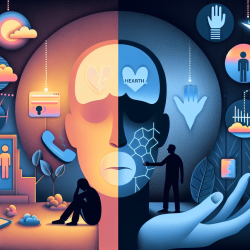The human brain's ability to adapt and reorganize itself after injury is a fascinating area of study. Recent research titled "Plasticity in the developing brain: neurophysiological basis for lesion-induced motor reorganization" sheds light on this remarkable capability, particularly in children. As practitioners working with young patients, understanding these mechanisms can significantly enhance therapeutic outcomes.
The Power of Plasticity
Brain plasticity refers to the brain's ability to reorganize itself by forming new neural connections. This adaptability is especially pronounced in children, whose brains are still developing. The study highlights how injuries to the motor cortex can lead to different types of reorganization, depending on factors like the timing and nature of the injury.
Key Findings from the Research
- Interhemispheric vs. Intrahemispheric Reorganization: The study found that acquired injuries are more likely to lead to interhemispheric reorganization, where motor function shifts to the opposite hemisphere. Conversely, developmental disorders often result in intrahemispheric reorganization, where the same hemisphere adapts.
- Ages and Injury Timing: Injuries occurring before the age of two are more likely to result in bilateral motor representation from a single hemisphere.
- Functional Outcomes: The type of reorganization significantly impacts functional recovery. Interhemispheric reorganization is often associated with poorer motor function compared to intrahemispheric reorganization.
Applying Research Insights in Practice
This research provides valuable insights that can be applied in therapeutic settings:
- Early Intervention: Understanding that early injuries lead to different reorganization patterns emphasizes the importance of timely intervention. Tailoring therapy strategies based on the type and timing of injury can improve outcomes.
- TMS as a Tool: Transcranial Magnetic Stimulation (TMS) has proven effective in mapping motor cortex activity and understanding reorganization patterns. Incorporating TMS into assessment protocols can help refine treatment plans.
- Customized Therapy Plans: Recognizing whether a patient is experiencing interhemispheric or intrahemispheric reorganization allows therapists to customize rehabilitation exercises that target specific neural pathways.
The Road Ahead: Encouraging Further Research
The findings from this study open up numerous avenues for further exploration. Practitioners are encouraged to delve deeper into how specific therapeutic interventions can influence brain plasticity and optimize recovery. Collaborative research efforts can lead to innovative treatment approaches that harness the full potential of neuroplasticity.
The study "Plasticity in the developing brain: neurophysiological basis for lesion-induced motor reorganization" offers a comprehensive look at these mechanisms and their implications for therapy. By staying informed and integrating these insights into practice, therapists can make a significant impact on their patients' lives.
To read the original research paper, please follow this link: Plasticity in the developing brain: neurophysiological basis for lesion-induced motor reorganization.










